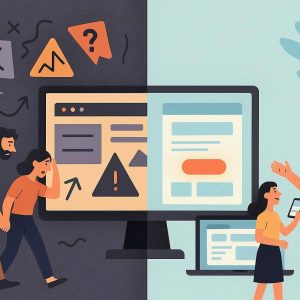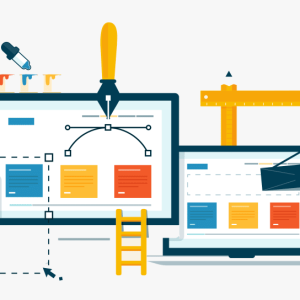If you’re looking to break into the web world, you’ve probably come across this question: What’s the difference between a developer and a web designer? Many people confuse these two roles, but the truth is that web development and web design are two completely different paths.
In this article, we’ll take a closer look at each of these jobs, explore the tools and skills required for each, and even explain the right personality for these careers. By the end, you will not only understand the difference between a developer and a web designer, but also which career path is best for you.
فهرست مطالب
ToggleIf you want to make the right decision for your future career, stay with us until the end of this article!
Difference Between Developer and Web Designer: Which Role Is Best for You?
When it comes to Website design and web development, many people confuse these two concepts. But the difference between a developer and a web designer is exactly like the difference between a mechanical engineer and an industrial designer in the automotive industry. To better understand this difference, imagine that a car is going to be built.
What does a web designer do?
A web designer works like an industrial designer of a car. He designs the appearance of the car to be attractive and user-friendly. In the web world, this means designing the user interface (UI), choosing colors, fonts, buttons, and optimizing the user experience (UX) to ensure that users can navigate the site easily.
What is the role of a web developer?
On the other hand, a web developer works like a mechanical engineer in a car. He or she builds the engine, transmission, and other technical components so that the car (or site) can function properly. Developers are responsible for coding and programming the site so that its technical functionality is flawless.
Key Differences Between Web Design and Web Development
To summarize the differences between these two roles:
- A web designer focuses on the appearance and user experience of the site.
- A web developer works on the functionality and technical implementation of the site.
In fact, both roles complement each other and without their cooperation, a complete and professional website cannot be built.
If you are interested in creative work, visual design, and user experience, becoming a web designer is probably a better option for you. But if you are interested in coding, solving complex problems, and implementing various functionalities on the site, the web development path will be more suitable for you.
The difference between a developer and a web designer is more than just appearance and coding. Each of these professions requires its own skills and tools. Now that you are familiar with the differences between these two career paths, you can better decide which field is best for you.
If you are planning to enter the world of the web, choosing the right path is your first step to success.
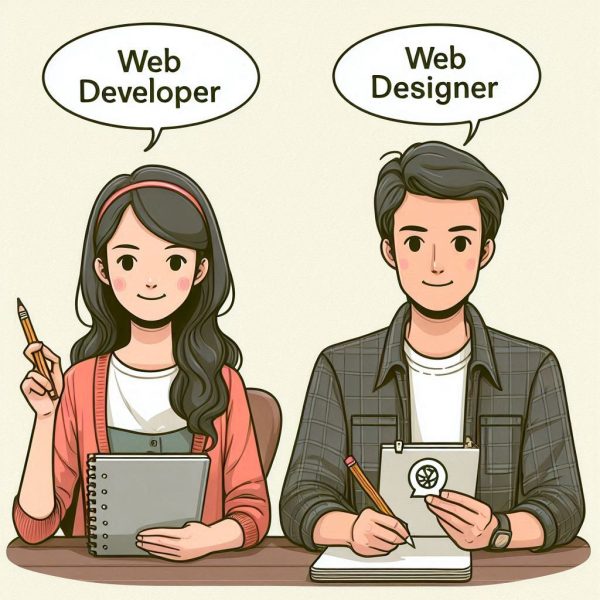
How much does a web developer and web designer earn?
One of the important questions that many people ask when choosing a career path in the web world is how much does a web developer and a web designer earn? The answer to this question depends on various factors such as where you live, work experience, skill level, type of projects, and even type of contract (full-time or freelance).

Web Developer Income
Web developers usually earn higher incomes than web designers, especially if they work in fields such as back-end development, full-stack, and artificial intelligence.
✅ In developed countries such as the United States, Canada, and Europe, web developers’ annual income ranges between $50,000 and $150,000.
✅ In Iran, web developers’ income depends on their level of skill and experience, and usually ranges between 15 and 50 million Tomans per month. People who work as freelancers and take on international projects can even earn dollars.
Web Designer Income
Web designers also earn a decent income, but it is usually slightly less than developers. The reason for this is that web design does not require in-depth coding knowledge and learning it is faster than web development.
✅ In developed countries, web designers’ income is usually between $40,000 and $100,000 per year.
✅ In Iran, depending on the skill level, the amount of projects, and the job market, web designers usually earn between 10 and 40 million Tomans per month. Professional designers who do international projects can earn higher incomes.

Tools Used in Web Development and Design
One of the key differences between a developer and a web designer is the tools they use to do their jobs.
Tools Used by Web Developers
Web developers use a variety of programming tools and languages to program and create site functionality, including:
- HTML, CSS, and JavaScript (for front-end design)
- PHP, Python, js, Ruby (for back-end development)
- js, Angular, Vue.js (JavaScript frameworks for user interface design)
- MySQL, MongoDB, PostgreSQL (databases (for storing information)
- Git and GitHub (for managing code versions)
- Code editors like VS Code and Sublime Text
In addition, developers use command-line interfaces (CLI) and version control systems to manage changes to their projects.
Tools used by web designers
Web designers focus more on visual aesthetics and user experience and use graphic and UI/UX design software to design the graphical interfaces of the site:
- Adobe Photoshop and Illustrator (for graphic and vector design)
- Figma and Adobe XD (for user interface design and prototyping)
- Sketch and Inkscape (for vector design and alternative to Adobe Illustrator)
- Canva (for quick and easy designs)
- Wireframes and prototypes (for testing user experience and site layout)
Web designers can also use user behavior analysis tools like Google Analytics to see how users interact with the site.

The Difference Between Web Designer and Web Developer Portfolios
Whether you are a web designer or a web developer, having a strong portfolio is one of the most important factors in your success in this field. Professional portfolios can best showcase your skills, experience, and creativity and gain the trust of potential employers and clients. But the difference between a developer and a web designer is evident in how these portfolios are presented.
Web Developer Portfolios
Web developers focus more on coding quality, technical performance, and site optimization. To showcase their skills, they usually use specialized programming platforms, including:
✅ GitHub and GitLab: These platforms are used to showcase project source code, how code is organized, collaborate on open source projects, and coding skills. Having an active profile on GitHub can go a long way in attracting the attention of employers.
✅ Cloud-hosted websites: Many developers use services like AWS (Amazon Web Services), Heroku, and Vercel to host their projects. These platforms allow them to implement real-world examples of websites and web applications and provide them to clients.
✅ Personal portfolio website: Having a dedicated website that includes completed projects, technologies used, and work experiences can have a positive impact on a developer’s personal brand.
Web designer portfolios
Unlike developers who focus more on coding and technical functionality of the site, web designers care more about visual aesthetics, user experience (UX), and user interface (UI) design. They use specialized graphic design tools to showcase their portfolios, including:
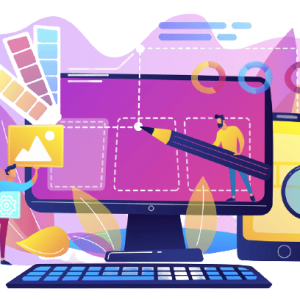
✅ Behance and Dribbble: These two platforms are among the most popular places to showcase designers’ portfolios. On these websites, designers can showcase their creativity in graphic design, color choices, typography, and user interface.
✅ Figma and Adobe XD: Many web designers use these tools to design wireframes, prototypes, and user interface (UI) designs, and publish their designed files directly to these tools.
✅ Personal Portfolio Website: Having a personal portfolio website allows designers to develop their personal brand and have complete control over how their work is displayed. On this website, they can publish previous projects, the design process, and even their articles and tutorials.

Do web developers and designers use more of the left or right hemisphere of their brain?
One of the common questions that comes up when examining the differences between web developers and designers is whether these two groups of people use more of the left hemisphere of their brain (associated with logic and analysis) or the right hemisphere of their brain (associated with creativity and visualization).
According to the traditional view, people with stronger logical and analytical thinking tend to perform better in web development, as this field requires coding, solving complex problems, and working with data structures. On the other hand, people with a high artistic and creative taste will be more successful in web design, as this work focuses more on visual beauty, user experience (UX), and color and typography choices.
But is this thinking correct?
Right or left hemisphere? The truth you need to know!
Scientific research has shown that dividing people into left-brain or right-brain is not very accurate. Contrary to popular belief, no one uses only one hemisphere of their brain. As Neil deGrasse Tyson says:

“Don’t call me left-brained or right-brained, call me human.”
Simply put, a web designer, in addition to being creative, needs to know the principles of user interface (UI) design, user experience (UX), and even the basics of coding, which are also skills associated with the left hemisphere of the brain. On the other hand, a web developer needs to have a good understanding of visual design and user experience, which are associated with the right hemisphere, to design attractive and functional websites.
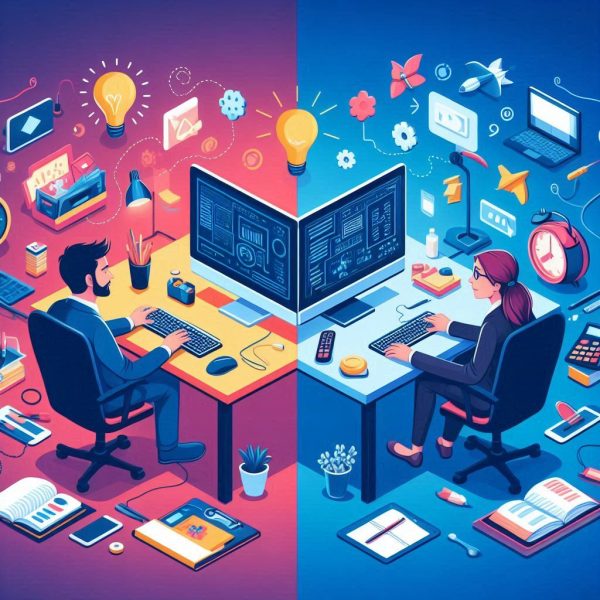
Conclusion: A combination of both skills is the key to success!
If you’re planning to enter the world of web design or development, you don’t have to worry about whether your brain is more inclined towards logic and analysis or creativity and visualization. The truth is that to succeed in both areas, you need to use a combination of both skills.
🔹 Web developers must be familiar with design principles in addition to technical knowledge to be able to create a smooth and enjoyable experience for users.
🔹 Web designers can also provide more practical and executable designs if they are familiar with the basics of programming and web interactions.
So instead of worrying about whether you use more of the left or right hemisphere of your brain, focus on learning the necessary skills. With practice and experience, you can excel in both areas of web design and development!
In the end
In this article, we examined the differences between a developer and a web designer from various aspects. We found that web developers focus more on coding, logic, and technical infrastructure, while web designers are responsible for the visual aesthetics, user experience, and overall appeal of the site. Although these two paths differ in terms of skills and tools used, the ultimate goal of both is to create a functional and attractive website for users.

We also found that, contrary to popular belief, no one is completely right-brained or left-brained, and a combination of logical thinking and creativity is required to succeed in either profession. Web developers need to have a good understanding of design principles, and web designers should also have some familiarity with coding and website functionality.
Ultimately, the choice between web design and development depends on your interests, skills, and career goals. If you are interested in solving technical problems and coding, web development is a better fit for you. But if you care about creativity, colors, and the visual experience of users, web design could be a better choice. Of course, you can become a Full Stack expert by combining these two skills and gain expertise in both fields.
So, the most important thing is to choose your path consciously, learn the necessary skills, and always be learning and updating your information to succeed in this competitive world.
Original Publication Date: 10/19/1400Update Date: 11/25/1403



